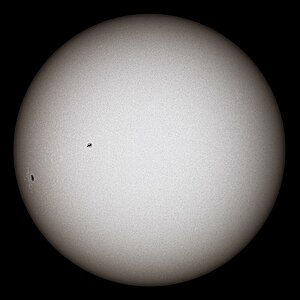Mata panas
bintang ba pusat Sistem Solar
(Dikalihka ari Matahari)
Mata panas nya siti bintang ba tengah Sistem Solar. Iya nya sfera plasma angat ti besai sereta nyau deka sempurna, dipanas nyentukka nyadi pijar nengah reaksyen fusi nuklear dalam teras iya, mansutka tenaga ari permukaan iya tebal agi nyadi penampak ti tampak enggau radiasyen inframerah enggau 10% ba tenaga ultraviolet. Iya jauh nyadi pun penatai kuasa ti pemadu beguna ngagai pengidup ba Bumi. Mata panas udah nyadi objek ti dipebasaka dalam mayuh budaya. Iya udah nyadi subjek tengah ungkup pansik astronomi kenyau ari jeman kelia.
 The Sun, filmed through a clear solar filter | |
| Names | Sun, Sol,[1] Sól, Helios[2] |
|---|---|
| Adjectives | Solar[3] |
| Symbol | |
| Observation data | |
| Mean distance from Earth | 1 AU 149,600,000 km 8 min 19 s, light speed[4] |
| −26.74 (V)[5] | |
| 4.83[5] | |
| G2V[6] | |
| Metallicity | Z = 0.0122[7] |
| Angular size | 0.527–0.545°[8] |
| Orbital characteristics | |
Mean distance from Milky Way core | 24,000 to 28,000 light-years[9] |
| Galactic period | 225–250 million years |
| Velocity |
|
| Obliquity |
|
Right ascension North pole | 286.13° (286° 7′ 48″)[5] |
Declination of North pole | +63.87° (63° 52′ 12"N)[5] |
Sidereal rotation period |
|
Equatorial rotation velocity | 1.997 km/s[11] |
| Physical characteristics | |
Equatorial radius | 6.957 x 108 m[12] 109 × Earth radii[11] |
| Flattening | 0.00005[5] |
| Surface area | 6.09×1012 km2
|
| Volume |
|
| Mass | |
| Average density | 1.408 g/cm3 0.255 × Earth[5][11] |
| Age | 4.6 billion years[13][14] |
Equatorial surface gravity | 274 m/s2[5] 27.9 g0[11] |
| ≈0.070[5] | |
Surface escape velocity | 617.7 km/s 55 × Earth[11] |
| Temperature |
|
| Luminosity | |
| Color (B-V) | 0.656[15] |
| Mean radiance | 2.009×107 W·m−2·sr−1 |
Photosphere composition by mass | |
Penerang
edit- ↑ Penyalat nyebut: Tag
<ref>tidak sah; tiada teks disediakan bagi rujukan yang bernamaOED - ↑ Penyalat nyebut: Tag
<ref>tidak sah; tiada teks disediakan bagi rujukan yang bernamaLexico - ↑ Penyalat nyebut: Tag
<ref>tidak sah; tiada teks disediakan bagi rujukan yang bernamaOED2 - ↑ Pitjeva, E. V.; Standish, E. M. (2009). "Proposals for the masses of the three largest asteroids, the Moon–Earth mass ratio and the Astronomical Unit". Celestial Mechanics and Dynamical Astronomy (id jaku Inggeris). 103 (4): 365–372. Bibcode:2009CeMDA.103..365P. doi:10.1007/s10569-009-9203-8. ISSN 1572-9478. S2CID 121374703. Diarkib ari asal ba 9 July 2019. Diambi 13 July 2019.
- ↑ 5.00 5.01 5.02 5.03 5.04 5.05 5.06 5.07 5.08 5.09 5.10 5.11 5.12 5.13 Williams, D. R. (1 July 2013). "Sun Fact Sheet". NASA Goddard Space Flight Center. Diarkib ari asal ba 15 July 2010. Diambi 12 August 2013.
- ↑ Zombeck, Martin V. (1990). Handbook of Space Astronomy and Astrophysics 2nd edition. Cambridge University Press. Diarkib ari asal ba 3 February 2021. Diambi 13 January 2016.
- ↑ Asplund, M.; Grevesse, N.; Sauval, A. J. (2006). "The new solar abundances – Part I: the observations". Communications in Asteroseismology. 147: 76–79. Bibcode:2006CoAst.147...76A. doi:10.1553/cia147s76. ISSN 1021-2043. S2CID 123824232.
- ↑ "Eclipse 99: Frequently Asked Questions". NASA. Diarkib ari asal on 27 May 2010. Diambi 24 October 2010.
- ↑ Francis, Charles; Anderson, Erik (June 2014). "Two estimates of the distance to the Galactic Centre". Monthly Notices of the Royal Astronomical Society. 441 (2): 1105–1114. arXiv:1309.2629. Bibcode:2014MNRAS.441.1105F. doi:10.1093/mnras/stu631. S2CID 119235554.
- ↑ Hinshaw, G.; Weiland, J. L.; Hill, R. S.; Odegard, N.; Larson, D.; et al. (2009). "Five-year Wilkinson Microwave Anisotropy Probe observations: data processing, sky maps, and basic results". The Astrophysical Journal Supplement Series. 180 (2): 225–245. arXiv:0803.0732. Bibcode:2009ApJS..180..225H. doi:10.1088/0067-0049/180/2/225. S2CID 3629998.
- ↑ 11.0 11.1 11.2 11.3 11.4 11.5 "Solar System Exploration: Planets: Sun: Facts & Figures". NASA. Diarkib ari asal on 2 January 2008.
- ↑ 12.0 12.1 Prša, Andrej; Harmanec, Petr; Torres, Guillermo; et al. (2016-08-01). "NOMINAL VALUES FOR SELECTED SOLAR AND PLANETARY QUANTITIES: IAU 2015 RESOLUTION B3 * †". The Astronomical Journal. 152 (2): 41. arXiv:1510.07674. doi:10.3847/0004-6256/152/2/41. ISSN 0004-6256.
- ↑ Bonanno, A.; Schlattl, H.; Paternò, L. (2002). "The age of the Sun and the relativistic corrections in the EOS". Astronomy and Astrophysics. 390 (3): 1115–1118. arXiv:astro-ph/0204331. Bibcode:2002A&A...390.1115B. doi:10.1051/0004-6361:20020749. S2CID 119436299.
- ↑ Connelly, J. N.; Bizzarro, M.; Krot, A. N.; Nordlund, Å.; Wielandt, D.; Ivanova, M. A. (2 November 2012). "The Absolute Chronology and Thermal Processing of Solids in the Solar Protoplanetary Disk". Science. 338 (6107): 651–655. Bibcode:2012Sci...338..651C. doi:10.1126/science.1226919. PMID 23118187. S2CID 21965292.Templat:Registration required
- ↑ Gray, David F. (November 1992). "The Inferred Color Index of the Sun". Publications of the Astronomical Society of the Pacific. 104 (681): 1035–1038. Bibcode:1992PASP..104.1035G. doi:10.1086/133086.
- ↑ "The Sun's Vital Statistics". Stanford Solar Center. Diarkib ari asal ba 14 October 2012. Diambi 29 July 2008. Citing Eddy, J. (1979). A New Sun: The Solar Results From Skylab. NASA. p. 37. NASA SP-402. Diarkib ari asal ba 30 July 2021. Diambi 12 July 2017.